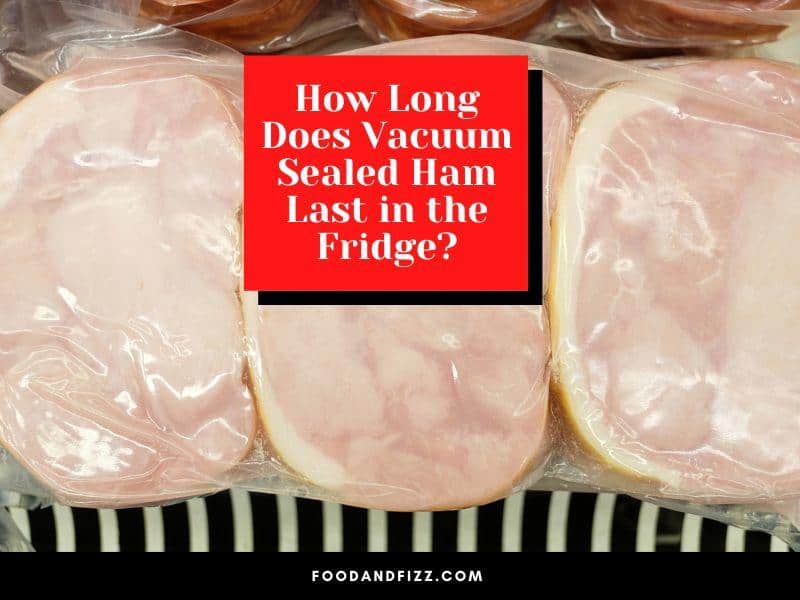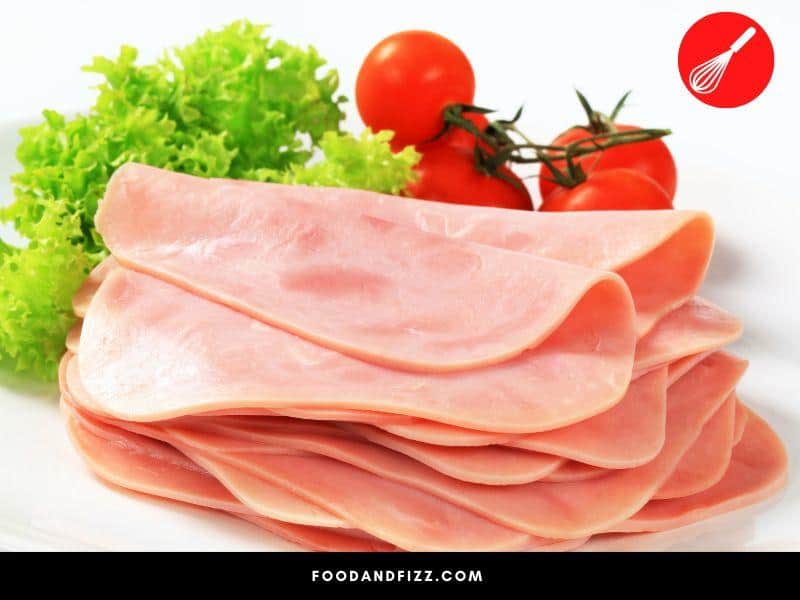Ham is one of the most popular types of pork meat and like bacon, is often enjoyed as a breakfast staple. It can be cured or uncured, smoked or unsmoked, and combined with other seasonings and ingredients to create diverse flavors.
To preserve freshness, they are usually sealed in plastic and vacuum-packed when you buy them from the store.
Vacuum sealing meat removes oxygen from the package and prevents bacteria from building up and prevents food spoilage-causing chemical reactions from acting on the meat, thus making it last longer.
Processed meats like ham also benefit from this practice. But just how long can they be kept in the fridge?
How Long Does Vacuum Sealed Ham Last in the Fridge?
Vacuum-sealed ham lasts for two weeks in the fridge when unopened and 3-5 days when opened. When the use-by date is specified on an unopened package of ham, the ham must be consumed before that date.

How Long Can I Store My Vacuum Sealed Ham In The Fridge?
Depending on the type of ham, whether it is fresh or cured, and how it was packaged or wrapped, the shelf life may vary.
Uncured, fresh ham that is cooked or uncooked will remain good in the refrigerator for 3-5 days. Cured ham that is cooked or uncooked will last anywhere from 3-7 days unless there is a “use-by” date indicated. A whole ham that is wrapped in the store, will last anywhere from 3-5 days.
On average then, ham will only last for about one week inside the fridge, but vacuum sealing it will increase its shelf life.
According to the USDA, an unopened, vacuum-sealed ham will last for 2 weeks in the fridge or until the “use-by” date indicated on the package. Once opened, this brings down the shelf life to the usual 3-5 days.
This is because, while vacuum-sealed, bacteria, mold, and other pathogens are safely kept out of the meat and the package. Once opened, oxygen is able to seep in, and with it, bacteria that cause food spoilage.
While vacuum sealing ham protects it and makes it last longer, it will not make it last forever. How it is stored and whether it is opened or unopened, will determine how long it lasts in the fridge.

How Long Does Vacuum Sealed Ham Last in the Freezer?
On average, ham lasts about a week in the fridge. What about the freezer?
According to the USDA, ham, regardless of the type and whether it is cooked or uncooked, lasts indefinitely in the freezer, but to ensure the best quality of the meat, it is best to stick to certain timelines.
Fresh, uncooked ham lasts about 6 months in the freezer while the cooked variety is recommended to be frozen from 3-4 months only.
In the same way, cured, uncooked ham lasts 3-4 months, while the cooked variety lasts only 1-2 months in the freezer.
All other cooked varieties of ham, including the vacuum-sealed ones, are advised to be stored in the freezer for no longer than 2 months.
This, of course, assumes that the ham is properly wrapped in foil or plastic wrap and kept protected in airtight containers.
What is Ham?
Ham is a kind of processed pork meat that is made from the back legs of the pig. The term usually pertains to both the whole leg and those that are sliced and packaged.
Ham can be fresh (uncured) or cured through salting and drying. It can be smoked or unsmoked.
Like bacon, it is a staple on breakfast tables and is a type of processed meat. Bacon is made from the pork back or belly, while ham is made from pork legs.
Types of Ham
Ham can be classified into three types.
1. City Ham
City hams are the most common type of ham. These are the ones you would normally find in the grocery store. They are “wet-cured” using a brining solution and can be uncooked or pre-cooked and ready to eat.
2. Country Hams
Country hams are typically dry-cured, smoked, and aged for months to years. They are typically sold uncooked and can be harder to find. They can be very salty and dry, but certain varieties have huge followings.

3. Fresh Ham
Fresh ham is uncured, unprocessed, and uncooked and would typically be labeled as such. It is also called “green ham”.
As it is unflavored and uncooked, you would have more freedom in the type of seasonings you would like to add to it to create your own unique version of ham.
No matter the type of ham, it is a well-known fact that many people are just enamored with this type of pork meat.
Purpose of Vacuum Packing Ham and Other Food
Making food last longer and making it accessible has always been one of the main goals of human society.
This is why, even thousands of years ago, we see evidence of people inventing multiple ways to preserve their food to ensure that they will always have something to eat no matter the circumstances.
Methods like drying under the sun, or storing food in salt or vinegar, have been around for thousands of years and are known to be the earliest methods of preserving food.
Over the last hundred years or so, food preservation has advanced dramatically with the advent of refrigeration, canning, and vacuum-sealing.
Now, more than ever, our food is much safer and lasts longer.
What is Vacuum Packing?
Vacuum packing is the process of removing all the oxygen from a package prior to sealing. It was invented in the 1950s by Karl Busch, a German inventor, who thought that it was a way to make food last longer.
Removing all the oxygen from a package deprives bacteria and mold of something that is essential for their survival. They cannot survive or thrive without oxygen. Removing this from the environment or the package ensures that they will not have a chance to act on the food and cause it to spoil.
Removing oxygen also inhibits chemical reactions that may speed up food spoilage and deterioration, thus allowing food to last longer.
Aside from preserving food and increasing its shelf life, vacuum packing also:
- Protects food from freezer burn
- Preserves food texture and taste
- Minimizes cross-contamination
- Reduces waste
- Increases fridge and freezer storage space
Not only does vacuum packing protect food from spoilage and allow it to last for a longer time, but it also has other advantages in that it preserves the integrity of food and offers a way to reduce wastage and maximize space.

Vacuum Packed vs Plastic Wrap
Sometimes, we see meat that is wrapped in plastic but is not what would be considered vacuum-sealed. Is this safe and will it make meat last longer too?
Plastic-wrapped meats are common, especially in grocery stores. While it does offer some physical protection to meat, it does not keep bacteria and mold out as it still allows oxygen to permeate the package. The traditional plastic film does not keep oxygen out, thus, food will still deteriorate as normal.
For example, bacon can commonly be found vacuum-packed if from the grocery store, but if it is fresh bacon from the butcher, it may just be wrapped in plastic. This just means that the one that isn’t vacuum-sealed will deteriorate faster. However, if there is air in the package in what is supposed to be a vacuum-sealed package, then you must not consume it. Read more at: Bacon Package Not Vacuum-Sealed.
Vacuum-packed meat, when available, offers a better choice, as they last longer and are more effective in keeping bacteria and pathogens out of your food.
It doesn’t mean though, that it protects from every type of pathogen or that it will last forever. You must still keep your meat chilled and properly stored.
How To Tell If Ham Has Gone Bad
No matter how properly it was stored, your ham will eventually deteriorate and go bad. So how do you know when it’s time to throw it out?
Expiry Date
Most packaged meat would have a use-by or best-by date on the label. If your ham has gone past the use-by date or it has been more than a week after the sell-by date, it is best to discard it rather than risk a food-borne illness.
Appearance
Ham will range in color from light beige to light pink, to rose or mahogany. If there are any other colors such as green, black or gray, or if you see any visible mold or unusual spots, it is best thrown away.
Smell
You will definitely know when meat is spoiled as it will have an off-putting, sulfuric smell. If your ham smells like this or has any other strange smells, it is best discarded.
Texture
If your ham has become sticky or has a slimy texture, it means it has gone bad and it is time to get a new package of ham.

Risks Of Eating Spoiled Ham
Ham that is spoiled will not be pleasant to eat at all. Besides this, you are also putting yourself at risk for a potentially serious food-borne illness.
If you eat spoiled or contaminated meat, you run the risk of developing symptoms like:
- Nausea
- Vomiting
- Diarrhea
- Fever
- Stomach pain and cramps
- Muscle aches
- Headaches
- Dizziness
- Cognitive problems
While most of these symptoms clear away on their own, there is always the risk that they will become more serious, especially if you are an immunocompromised individual.
It is better to always be careful and prudent with what we consume and to always ensure that food, especially meat, is properly handled and stored.
It is best to use our senses and sound judgment in the foods we consume and to take responsibility for our own health.
Read next: How Long Can Cooked Ham Stay Out Of the Fridge
Conclusion to How Long Does Vacuum Sealed Ham Last in the Fridge?
An unopened pack of vacuum-sealed ham will last for two weeks in the fridge, or until the best-by date indicated by the manufacturer as long as it is properly stored.
Once opened though, the shelf life decreases to about 3-5 days in the fridge.
If you want your ham to last longer, you may choose to store it in the freezer instead. As long as it is properly wrapped and stored, cooked or uncooked ham will last several months in the freezer.
Frequently Asked Questions to How Long Does Vacuum Sealed Ham Last in the Fridge?
What is Ham?
Ham is a kind of processed pork meat that is made from pork hind legs. It can be wet-cured using brine or dry-cured with salt and other seasonings and can be smoked or unsmoked. A certain type of ham called fresh ham is unsmoked, uncured, and unflavored.
Can I Store Vacuum Packed Ham in the Freezer?
Vacuum-packed ham can be stored in the freezer and will last from 1-2 months.
Why Are Meats Vacuum Packed?
Vacuum packing removes all the oxygen from the package prior to sealing. Removing the oxygen inhibits the growth of bacteria and mold, and slows down the process of food spoilage.
Is Ham The Same As Bacon?
Ham and bacon are both pork-derived products. They are both cured and processed. Bacon is processed using the belly or back of the pig, while ham is meat that is taken from the back legs of the pig.

